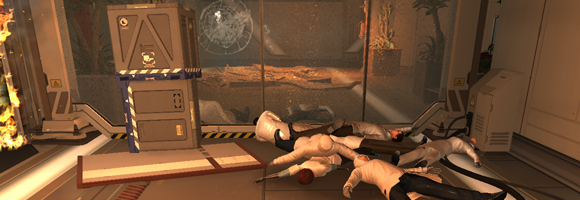
My new hardware components will arrive on Thursday, but I couldn’t keep my hands off ↵DX3. So I went back to the beginning of the story, where framerates still are decent, and tried to find a suitable object for KerLeone’s ↵suitcase challenge. I searched David Sarif’s office thoroughly—while he kept on urging me to hurry and go see what the matter was in lab subsection 6—but couldn’t find a single object which was manipulable. In the corner behind David’s desk I saw his suitcase, already packed for our projected trip to D.C., and my hopes went up. But nothing, zero, zilch. The suitcase and all the things in the office are pure decoration, glued in place, not subjected to ingame physics.
With a sigh I entered the elevator and rode it down to lab 6, where the alert was triggered. Same thing, every object in the corridors is unmovable geometry. The first ‘object’ I encountered which I could pick up was a corpse, the first of the slaughtered scientists I found. Already I prepared myself to drag a corpse through the whole game, like the original Django dragged that dreaded coffin through the whole movie.
Then I approached the point where I have to circumvent the indestructible—I emptied several magazines into it—glass wall by crawling through an air duct. The duct is blocked by a crate standing atop another one. The first two movable objects I encounter which weren’t formerly alive. Alas, the crates are far too big and won’t fit into the ventilation shaft. Likewise it’s impossible to stuff the corpse into it. I tried.
The next quarter of an hour or so I entertained myself by collecting all the movable objects I found so far—the result can be seen in the screenshot above. You can drag around the corpses freely (this will make sense later in the game, because it enables you to hide your unconscious or even dead victims, so that you’re not detected by the others) and when you leave them lying alone they stay where you’ve put them. Motionless. As dead people should. But a bizarre zombifying effect occurs when you’re piling the corpses … or put a crate atop of them: Ragdoll physics let’s them twitch and jerk, like they’re trying to get up again.
talking cyberanthropology
 Several weeks before this year’s conference of the German Anthropological Association (GAA/DGV) took place (14-17 September in Vienna, Austria), Thomas Lohninger contacted me via e-mail. He is the founder of, and force behind ↑Talking Anthropology which went live in July 2009. Since then he has produced and brought online 39 podcasts, 16 of them in English. The idea of Talking Anthropology is to bring topics, notions, and ideas from social and cultural anthropology to a broader public. The podcast seems to be a fitting format for that endeavour. The download numbers, for some of his productions in the thousands, confirm the validity of Thomas’ approach.
Several weeks before this year’s conference of the German Anthropological Association (GAA/DGV) took place (14-17 September in Vienna, Austria), Thomas Lohninger contacted me via e-mail. He is the founder of, and force behind ↑Talking Anthropology which went live in July 2009. Since then he has produced and brought online 39 podcasts, 16 of them in English. The idea of Talking Anthropology is to bring topics, notions, and ideas from social and cultural anthropology to a broader public. The podcast seems to be a fitting format for that endeavour. The download numbers, for some of his productions in the thousands, confirm the validity of Thomas’ approach.
Just recently he has interviewed e.g. ↑Christoph Brumann, ↑Gustavo Lins Ribeiro, ↑Biella Coleman (on digital anthropology), and you will find many more interesting podcasts, like the one ↑featuring a member of the Takriz movement.
Happily I met his request, sat down with him in Vienna, and … shamelessly grabbed the opportunity [tnx a lot, Thomas :-] to hype my book ‘↑Cyberanthropology‘ [which you can order via amazon—did I mention that?]. I talked a bit too much about cybernetics to my taste, but judge for yourself: ↑TA37—Cyberanthropology [in German—for those who do not readily understand German: ’tis a great opportunity to listen to my mellow baritone for an hour and 37 minutes … just perfect if you got difficulties to find sleep].
godbox upgrade
It’ll be not long and I am back in the game. With ↵DX3 and the other goodies around it is obvious that after more than four and a half years an upgrade of my former ↵godbox has become unavoidable. Today I sprang headfirst into Tom’s Hardware and began doing research on current graphics cards. After a quick e-mail exchange with KerLeone (asking him what hardware he’s currently on) I went on with my research, but then thought: ‘Mine has to be bigger!’ So I skipped my plan to just replace the graphics card. Instead I opted for really upgrading the system and to walk the ↑sandy bridge. Here’s what I just ordered: Motherboard: Asus Sabertooth P67 | CPU: Intel Core i5-2400 | Memory: Corsair Vengeance 16GB | Graphics Cards: 2x Asus EAH6950 DCII 2DI4S 2GD5 (Crossfire) For good measure I threw in Windows 7, and—most importantly—↵Batman: Arkham City, the steelbook edition.
environmental malfunction
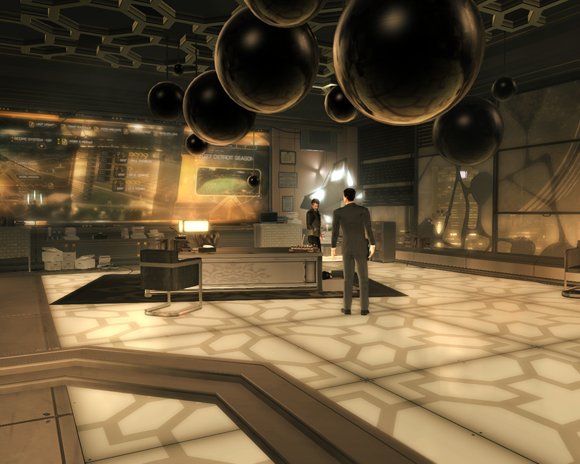
After our conversation in the elevator unfortunately is interrupted by ↑Francis Pritchard entering, ↑Megan Reed has to go and meet ↑Athene Margoulis, ↑David Sarif‘s executive assistant. The latter is my boss, the founder and CEO of ↑Sarif Industries, whom I now have to meet up in his office. And quite an office it is [see above], although not as impressive as the one of ↑Dr. Eldon Tyrell—but then again Sarif Industries is characterized as ‘a moderately-sized biotechnology company.’ For that the building housing his company is quite impressive.
While talking with the old man [strange to say that, as he is born in the same year as my offline self] about our upcoming visit to Washington D.C. suddenly—but not unexpected—the shit starts hitting the fan.
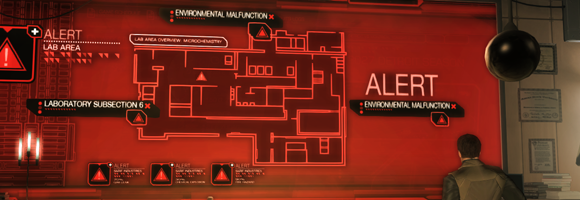
The building’s security system reports an environmental malfunction in laboratory subsection 6. As I am Sarif Industries’ chief of security I immediately head down to the lab in question, using the big man’s private elevator.
In best FPS-adventure tradition I first find blood-smeared floors and walls, then the corpses of dead laboratory personnel. It’s like Half-Life, Doom, Max Payne … I feel at home. Cautiously I advance and the system offers me the tutorials piecemeal. So I watch the movies, which are recordings of the very situation and place I find myself in right now. The ↑traditional crates are back as well—I can pick them up, move and throw them, very similar as in Half-Life 2 … which gave me an idea.
back in the days when Half-Life 2 was freshly out, KerLeone thought up a wonderful challenge. Manipulating ingame objects was one of Half-Life 2’s original features. When you arrived at City 17’s railway platform you found an orphaned suitcase on the platform, right after leaving the train. By means of that suitcase the game began to teach you it’s object-manipulating system. KerLeone had the idea to drag the suitcase from the railway station through the course of the whole game. The plan was to reach the final boss and kill him by hitting him with that very suitcase. Unfortunately it didn’t work out, because early in the game you have to use a teleporter which ↵malfunctions in three dimensions and refuses to transport the suitcase. We shall see if we can pull the stunt now in DX3.
Through a bullett-proof glass wall I have to witness how some heavily equipped mercenary slaughters a scientist (easily recognizable by his white laboratory coat). The wall is indestructible, so I look for a way around. Having entered an office the system prompts me to pick up and remove, yes, a crate. Behind the crate there’s an entry to the building’s airduct-system. Maybe that’s already the death of suitcase-from-the-station redux. Quite obviously I can’t stuff the crate into the airduct. I have to go back these days and see, if there is some object to pick up before.
When I finally have worked my way around the glass wall the goon is gone. Stealthily I sneak on until I encounter the first two terrorist-types, complete with black ski-masks. Max-Payne déja vu again.
Now it’s the time for getting comfortable with the moving and shooting system, and I realize that I’m a bit too oldschool. Me, my body, motor functions, and eye-hand coordination are accustomed to hide and seek cover by moving (using the WASD-keys) and crouching (the C-key), nothing more. That’s why I immediately felt comfortable with the moving-system of Far Cry 2—the addition of pointing the weapon by holding down the right mouse button (RMB) was easy to internalize.
Now, in DX3 holding down RMB makes Adam Jensen taking cover by kneeling down and hugging the wall or any other piece of large enough geometry close by (a crate?), plus switches from first-person to third-person perspective:
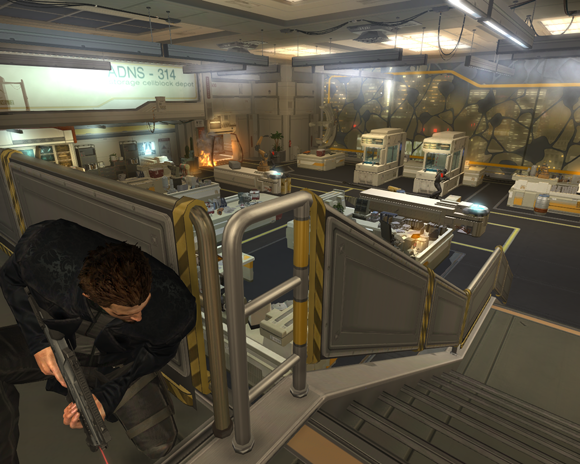
But that’s not it yet. By tapping the spacebar, Adam jumps to the next spot suited for cover—e.g. from one side of a doorway to the other. By holding down the spacebar he sneaks on under cover.
You really have to get accustomed to this, but I can clearly see the potential. Alas, I won’t be able to bring the movement system to full fruit soon, because on another level of reality the environment indeed begins to malfunction. My dated hardware simply cannot cope with the game in a satisfactory fashion. The frames per second drop here and now, plus I am getting artefacts, graphics glitches. My GPU, or CPU, or both simply are overstrained. Concerning the artefacts my system may even lack necessary shaders.
So I play around a bit, sneak on, and kill some of them ski-masked goons until I reach the spot pictured above. There the framerate drops again, still playable, but not the full fun. Hardware upgrade will be done. Stay tuned.
human revolution
When I entered the last chapter of ↑Far Cry 2 (Ubisoft Montreal 2008) my account read 178 diamonds. The sneaky bastard I am, I felt so comfortable once I had the combination of silenced P9, Dragunov, dart rifle, and the camouflage suit, there was no reason for me to spend anything on new equipment. The payments for accomplished missions came in, and the fortune amassed till ↑suicide was painless.
Somehow mixing this up with my bank account, the one my salary as an anthropologist goes to, yesterday evening I strolled into a shop and laid fifty quid down on the counter. In return I received a brand new copy of ↑Deus Ex: Human Revolution (DX3; Eidos Montreal & Nixxes Software 2011). I had read high praise of the game (carefully avoiding spoilers), the ↑Deus Ex series is not only as legendary as ↑Doom and ↑Half-Life, but also is purest cyberpunk imaginable (even the headquarters of the game’s publisher, Square Enix, is located in Shibuya and my friends over at cyberpunkreview.com ↑gave it nine out of ten stars).
Plus I again wanted to play a current title (DX3 was released in Europe only two weeks ago), and not hang back years as it was the case for so long—which is not completely true, as I played through ↑Call of Duty: Black Ops (Treyarch 2010) in June this year; article of mine on it pending.
You see, purchasing DX3 was an unavoidable must.

The installation process took about 20 minutes but went like a breeze, without any problems whatsoever. After firing up the game, the splash screen already confirms what was discussed in forums and reviews. The visual æsthetics blend futuristic with ↑baroque and ↑rococo elements. If memory serves me correctly, it was illustrator ↑Jim Burns who coined the term ‘baroque science fiction’ for this particular visual style.
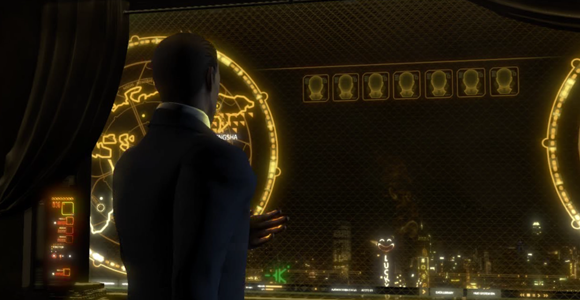
This is very much in synch with overall cyberpunk æsthetics, incorporating retro-elements. It’s of course not steampunk æsthetics, but somewhere within one and the same continuum of style.
An authors’ ruse also has impact on the visual style: DX3 is a prequel, set in 2027, 50 years before the stories of DX1 and 2. So the dominant technology is not yet nanotechnology, but electronics and electromechanics. This allows beautiful looking cyborg-parts, blending perfectly with the retrofitted future and leading to a more visual discussion of post- or transhumanism.
At cyberpunkreview.com zecalvin came to ↑this conclusion:
I have to admit I was both enthusiast and scared at the idea of a new Deus Ex. We could have feared that a cross platform project would have a poor gameplay, but Eidos Montreal has listened to it’s fan community to bring you a total masterpiece. Of course, everything is not perfect, but Human Revolution has kept the strength of the first game : rewarding gameplay, well written plot, excellent global design … This game is definitely worth playing. And for those who played the other games, Eidos has taken care of the fan service, so you’ll find a lot of easter eggs …
If you head over for reading zecalvin’s review (recommended), don’t miss its update, as it seems that Eidos Montreal indeed listened to the cyberpunk fanscene and for example ↑roamed around the cyberpunk review forums.
With the game up and running I first opt for the tutorials from the main menu, which are a bit of a disappointment. They are not playable as I expected, but videos with explanations by a female voice off camera. Presumably I will be made hands-on familiar with the gameplay mechanics during the opening parts of the story into which I now delve.
Beautifully detailed graphics unfold, immediately setting the ↑Blade Runner ambience. Dialogue-heavy ↑cutscenes pull me further inside the storyworld.
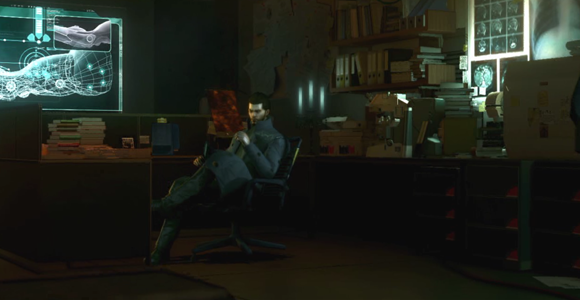
When I finally come out of the cutscenes and for the first time take control of ↑Adam Jensen, the game stutters a bit, and the engine begins culling textures. The detailed graphics lead my system to the edge. No wonder, as I built my machine back in March 2007. No improvement of the hardware done since then. Quite to the contrary, in December last year I had to ↵remove one of the graphics cards. So there will be no way around a hardware upgrade soon; a new CPU and graphics card in particular, maybe new and more RAM, too. Especially with ↑Rage (id Software 2011) already around and ↑Arkham City (Rocksteady Studios 2011) ↵looming at the horizon.
That’s it for now—yesterday night I only had a couple of minutes to take a glimpse into DX3. At the moment I can’t play on, because I have to do my tax declaration, which is way overdue. I wonder how I will explain those 178 African diamonds …
seventythree percent
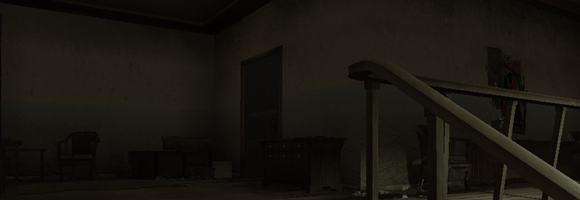
Just a li’l rant in-between, because this is hilarious and I have to let off a bit of steam.
I played through ‘↑Far Cry 2‘ (FC2) till 73% of the story mode, and now I am stuck. I have done all missions available, and the game prompts me to reach a briefing point to get a new mission. The only spot marked on the map where I can get a new mission is the headquarters of the ‘Alliance for Popular Resistance’ (APR) in Mosate Selao.
So I head there, the guy at the door takes away my weapons and ushers me in. Once inside first thing unusual is that no voices are to be heard. Anyway I climb the stairs to the first floor—and find the door to the briefing room closed. No way in. Methinks, all right, I’ve missed something else, go out again and take a new look on the map.
Now Mike’s Bar at the Marina and the APR-headquarters are flagged on the map as ‘mission available.’ At Mike’s I get a mission from a pal there, do the mission, return to Mike’s, tell the pal, back to APRHQ which is the only spot flagged with an exclamation mark. Briefing room still locked.
Maybe I have missed a mission in the northern map. Through the desert to Leboa-Sako. The cell towers there are flagged. From those I get two hitman contracts near the Airfield. Having blown away both marks, back through the desert … briefing room still locked.
So I take a good night’s sleep in one of my huts, hoping that the day-night cycle resets APRHQ. Doesn’t. Shutting down the game completely and restarting the system. To no avail.
Several forums on teh_Internets wisen me up: It’s a well known bug called the 73% bug. It can get you at 88%, too. And some poor souls I read of were struck at 27%. Although the bug is known since 2008, and although since then the game was patched up to version 1.03, the issue hasn’t been addressed.
Additional obscenity: There was a ↑wonderful glitch to exploit in FC2. By setting the mortar onto the ground close to a building’s wall and then rotating 180° the player was able to rotate himself through the wall into places where he shouldn’t be. Thing is, with 1.02 the glitch has been patched away—else I could’ve rotated myself into the briefing room. But they left in the real showstopper.
As it seems I’ve only got three options: 1) Patch down my installation, which is quite a hassle 2) Go back to some saved game and redo parts of the story, but I’ve read that this not necessarily leads to salvation 3) skip FC2 altogether.
End of rant.
UPDATE 1: Went back to the last savegame at 69%, once more blew up the pipeline and saved a buddy at the mine, then APRHQ was reset. Am at 88% now.
UPDATE 2: Am through, played both endings. Wonderful game—despite the annoying showstopper—am feeling the itch to start over again with another character ;-)
infiltration
my first ↑vig!
 The
The good Evil Doctor to be seen here just recently found out that his newest invention, the death-ray, is just perfectly suited for joining aquatic cartilage and human tissue. While welding the head of a ↑Galeocerdo cuvier upon his latest victim, the latter’s comrades have discovered a sneaky path into his well secured laboratory …
It’s not a mere tradition but a rule that supervillains, ↑mad scientists in particular, build their secret hide-outs and laboratories within or right above active volcanoes at the brink of eruption. In sharp contrast to public opinion this has significant advantages.
When ↑Shego asked ↑Dr. Drakken why he built his lair right inside a volcano, he replied: “Well, you know, it just substantially reduces the costs for heating.”
Quite plausible, isn’t it? Everybody requires heating. But there’s yet another angle to it, because besides heating mad scientists—unlike us—require amounts of energy on unprecedented scales.
Take e.g. our Doctor’s death-ray. Do you have an idea what that contraption consumes in terms of electricity? Geothermal heat here furnishes complete independence. Hence the lightning rod atop the roof is out of service.
Another rule from the same tradition dictates that despite of access to seemingly inexhaustible resources, and despite of superior intelligence and cunning, a twisted path into the villain’s sanctum sanctorium is always left open, so that his heroic enemies can defeat him. In our case here it is a trapdoor—which we always deem to be most appropriate—leading to the volcanic caverns filled with poisonous gas.
Quite frankly, why the ‘rule of the vulnerable fortress’ is in effect is beyond us. It might have something to do with dramaturgy or deus ex machina as some suggest. But those rationalisations seem to be a bit far-fetched. It’s more likely that we are dealing with something cultural here. Naturally, our Doctor could have sealed his sanctum sanctorium hermetically. But the archetypical supervillain just needs the confrontation with the heroes, hence he leaves the trapdoor open.
With my debut vignette’s cast I was very lucky. Mr. Kurt Russell immediately and enthusiastically accepted the role of the Doctor’s arch-nemesis, somewhat reprising his role as ↑Snake Plissken. For fighting at his side, and leading ahead up the ladder, I was able to get Mr. Robert Downey jr. The third team member, and I am especially proud of this, although you can’t see her face—which is a pity—is played by Ms. Milla Jovovich. Leaves us with the Doctor … yes, it’s Mr. Vincent Price himself!
[In the face of me not being much of a photographer, building it all black was not quite a bright idea …]
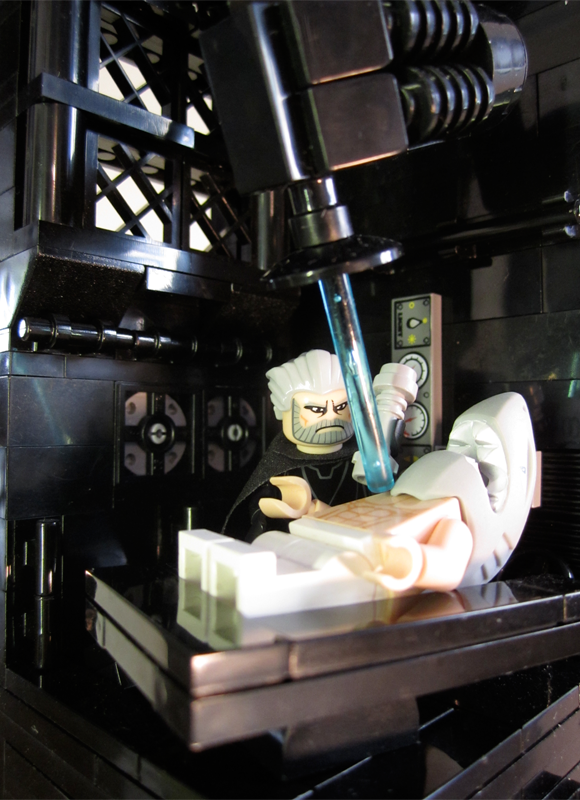
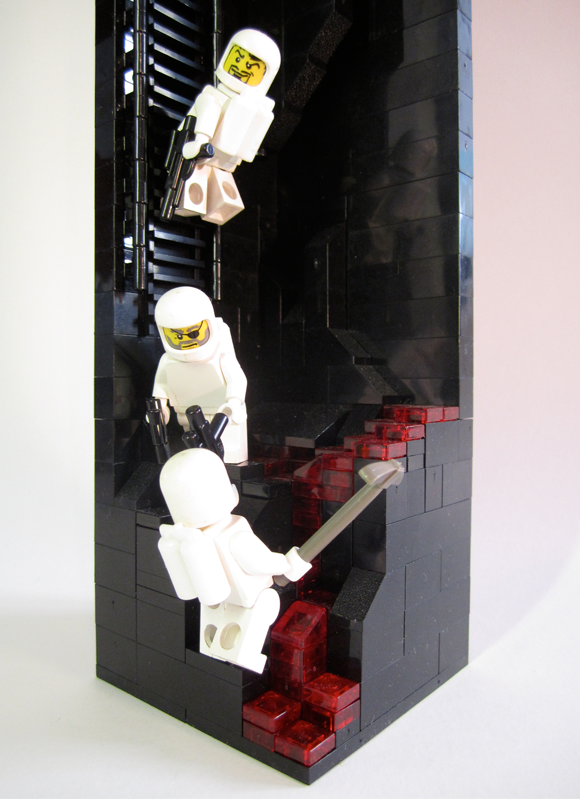
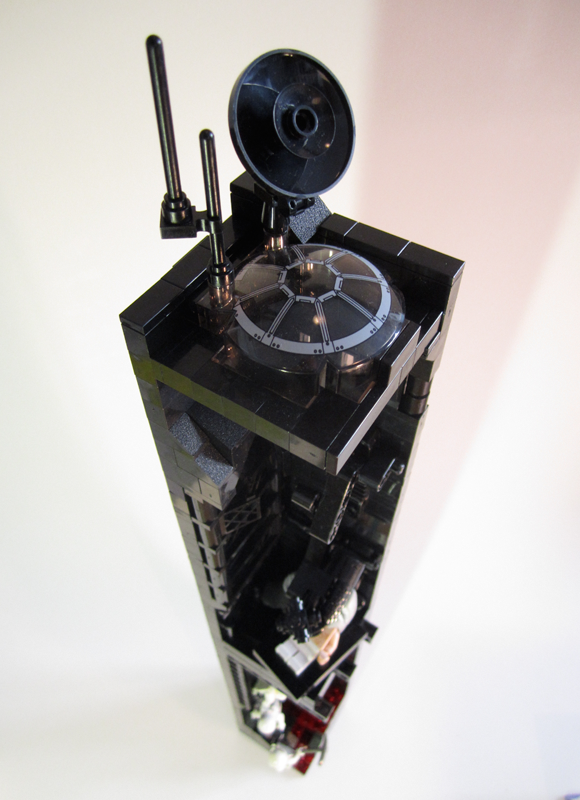
rogue states

It’s 20 years ago that Bruce Sterling drew a connection between ↑cyberpunk in the nineties and Jules Verne: ‘↑Captain Nemo was a technical anarcho-terrorist.’ (Sterling 1991: 39) By chance last night I stumbled over a passage in Verne’s ‘↓20,000 leagues under the sea‘ I had marked some time. It is part of a conversation between Ned Land [picture Kirk Douglas] and Professor Arronax. Together with Arronax’ trusty servant Conseil they in effect are prisoners aboard Nemo’s submarine ‘Nautilus’ and now speculate about their jailors’ origin:
“My opinion is formed,” replied Ned Land, sharply.
“They are rascals.”
“Good! and from what country?”
“From the land of rogues!”
“My brave Ned, that country is not clearly indicated on the map of the world; but I admit that the nationality of the two strangers is hard to determine. Neither English, French, nor German, that is quite certain. However, I am inclined to think that the commander and his companion were born in low latitudes. There is southern blood in them. […]” (Verne 1870: chpt. VIII)
Is this where the concept ‘↑rogue states‘ has its roots?
delineation
Some weeks ago I once again had a conversation on the distinctions between social/cultural anthropology and neighbouring or kin disciplines. On the very same day a bookseller sent me an e-mail advertising the (quite costly) “Encyclopaedia of Social Anthropology” by Indian sociologist Henna Tabassum (2011). The book’s ↑product overview gives a quite comprehensive description, which very much is in synch with my convictions:
Social anthropology is distinguished from subjects such as economics or political science by its holistic range and the attention it gives to the diversity of culture and society across the world and the capacity this gives the discipline to reexamine Euro American assumptions. It is differentiated from sociology, both in its main methods (based on long term participant observation and linguistic competence) and in its commitment to the relevance and illumination provided by micro studies. It extends beyond strictly social phenomena to culture, art, individuality, and cognition. While some social anthropologists use quantitative methods (Particularly those whose research touches on topics such as local economies, demography or health and illness) social anthropologists generally emphasize qualitative analysis of long-term fieldwork, rather than the more quantitative methods used by most economists or sociologists.
Today I googled for the book, pasting a sentence from above product overview into the searchfield, and got some hits—top of the heap is the section ↑substantive focus and practice of Wikipedia’s article on ↑social anthropology. The section’s opening paragraph is, word by word, identical with the product overview.
Now, who has copied from whom?
1945-1998
Japanese artist Isao Hashimoto has created a beautiful, undeniably scary time-lapse map of the 2053 nuclear explosions which have taken place between 1945 and 1998, beginning with the Manhattan Project’s “Trinity” test near Los Alamos and concluding with Pakistan’s nuclear tests in May of 1998. This leaves out North Korea’s two alleged nuclear tests in this past decade (the legitimacy of both of which is not 100% clear).
Isao Hashimoto himself on his ‘1945-1998’:
This piece of work is a bird’s eye view of the history by scaling down a month length of time into one second. No letter is used for equal messaging to all viewers without language barrier. The blinking light, sound and the numbers on the world map show when, where and how many experiments each country have conducted. I created this work for the means of an interface to the people who are yet to know of the extremely grave, but present problem of the world.
It’s ‘only’ a map of the world. For almost a quarter of an hour flashing lights appear on it, accompanied by sound-effects reminiscent of the 8bit-era. And it truly gave me the creeps; much more than the countless videos of nuclear detonations to be found on YouTube. Isao Hashimoto’s piece of art is one of the most haunting testimonies of man’s folly … forcefully posing the question, if we deserve being here at all.

